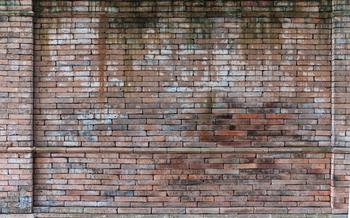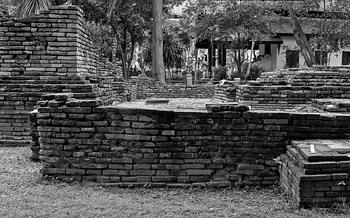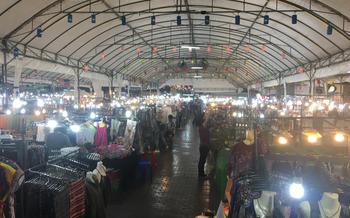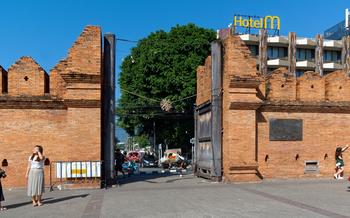
Chiang Mai Celadon
- Chiang Mai Celadon: A Legacy of Ceramic Craftsmanship
- Exploring San Kamphaeng Road
- The Process of Celadon Creation
- The Importance of Celadon's Glaze
- Supporting Local Artisans
- Unique Features of Chiang Mai Celadon
- Visiting Celadon Workshops
- Popular Celadon Products
- The Celadon Museum
- Shopping for Celadon
- Benefits of Owning Celadon Ceramics
- Integration of Celadon into Home Decor
- Unique Experiences in San Kamphaeng
- Tours and Workshops
- Insider Tip: Haggling and Bargaining
Chiang Mai Celadon: A Legacy of Ceramic Craftsmanship
History and Cultural Significance Chiang Mai Celadon, with its enchanting allure, holds a deep-rooted history in Northern Thailand, dating back to the Lanna Kingdom era. This distinctive ceramic ware, crafted with finesse and precision, has become a symbol of the region's rich cultural heritage. The name "Celadon" is derived from the Celadon glaze, a hallmark of this ceramic tradition. The glaze imparts a mesmerizing green hue to the pottery, ranging from soft jade to vibrant emerald, and is achieved through a complex firing process.
Unique Characteristics and Design Elements Chiang Mai Celadon stands out with its unique characteristics that distinguish it from other ceramic styles. The intricate designs, often inspired by nature and the local culture, are meticulously hand-painted or carved onto the clay surface. Floral motifs, swirling patterns, and auspicious symbols are commonly featured, reflecting the artisans' profound connection to their surroundings.
Importance of the Celadon Industry to the Local Economy The Celadon industry plays a crucial role in the local economy of Chiang Mai. For generations, families have passed down the craft from father to son, preserving the traditional techniques and designs. The industry provides employment opportunities and supports the livelihoods of numerous artisans and their families. By purchasing Celadon products, visitors can directly contribute to the sustainability and preservation of this cherished craft.
Exploring San Kamphaeng Road
San Kamphaeng Road, situated approximately 12 kilometers south of Chiang Mai, is renowned for its concentration of Celadon shops and kilns. This vibrant road offers a unique opportunity to immerse oneself in the world of Celadon ceramics.
Visitors can easily reach San Kamphaeng Road by taking a local bus or hiring a tuk-tuk from Chiang Mai. Upon arrival, they will be greeted by a bustling street lined with numerous shops and kilns, each showcasing a vast array of exquisite Celadon products.
The variety of Celadon items available is truly impressive, ranging from traditional tableware and decorative pieces to contemporary designs and souvenirs. Whether seeking a unique gift or a special addition to one's home décor, San Kamphaeng Road is a treasure trove for Celadon enthusiasts.
The Process of Celadon Creation
The creation of Chiang Mai Celadon is a meticulous and intricate process that has been passed down through generations of skilled artisans. It begins with the careful selection of raw materials, including high-quality clay and glazes. The clay is meticulously prepared and purified to remove impurities, ensuring its smoothness and durability.
Once the clay is ready, it is shaped into various forms using traditional techniques such as hand-building, wheel-throwing, or mold casting. The artisans demonstrate their expertise as they transform the clay into elegant and intricate shapes, showcasing their artistic vision and technical prowess.
The shaped clay pieces are then left to dry slowly to prevent cracking or warping. This drying process can take several days, depending on the size and thickness of the pieces. Once the clay is completely dry, it is ready for the firing process.
The firing process is crucial in the creation of Celadon ceramics. The pieces are placed in a kiln and subjected to high temperatures, typically ranging from 1200 to 1300 degrees Celsius. This intense heat vitrifies the clay, making it hard and durable, while also bringing out the distinctive green color of Celadon glaze.
After firing, the Celadon pieces are carefully inspected for any imperfections. Flawless pieces are then meticulously glazed, a process that involves applying a thin layer of liquid glaze to the surface of the ceramic. The glaze is made from a mixture of minerals and fluxes, which gives Celadon its characteristic glossy finish and enhances its durability.
The glazed pieces are then fired again at a lower temperature to fuse the glaze with the ceramic body. This firing process creates a smooth, impervious surface that is both aesthetically pleasing and functional. The resulting Celadon ceramics are not only beautiful but also highly durable, making them ideal for everyday use.
The Importance of Celadon's Glaze
Celadon's glaze is the defining characteristic that sets it apart from other types of ceramics. The process of glazing involves applying a thin layer of liquid clay or glass to the surface of the fired ceramic body. This layer is then fired again at a high temperature, causing it to melt and form a smooth, glassy finish.
The glaze is responsible for the Celadon's distinctive color and texture. The color of the glaze is determined by the type of clay and the presence of metal oxides. Celadon typically ranges from pale green to deep olive green, but it can also be found in shades of blue, brown, and yellow. The texture of the glaze is often smooth and satiny, but it can also be crackled or textured to create different visual effects.
The glaze also plays an important role in the durability and functionality of Celadon ceramics. The glaze creates a waterproof barrier that protects the ceramic body from stains and liquids. It also makes the ceramic more resistant to wear and tear, making it suitable for everyday use.
Supporting Local Artisans
The allure of Chiang Mai Celadon lies not only in its beauty but also in its cultural and economic significance. The Celadon industry is deeply intertwined with the local economy, providing employment and sustaining traditional craftsmanship. Purchasing Celadon products directly from artisans or reputable local shops ensures that the benefits of tourism are equitably distributed, empowering the talented individuals who dedicate their lives to this art form.
By opting for ethically sourced Celadon, you contribute to the preservation of traditional techniques and support the livelihoods of local artisans. Fair trade practices ensure that artisans receive fair compensation for their work, allowing them to continue practicing their craft and passing on their skills to future generations. Responsible tourism, in turn, fosters a thriving Celadon industry, safeguarding the cultural heritage of Chiang Mai and promoting sustainable economic development.
So, as you admire the exquisite Celadon pieces, take a moment to consider the human stories behind them. Your purchase becomes more than just a souvenir; it becomes an investment in preserving a living tradition and empowering the local community. Embrace the opportunity to support local artisans, promote fair trade, and make a positive impact on the Celadon industry, perpetuating its legacy for years to come.
Unique Features of Chiang Mai Celadon
Chiang Mai Celadon distinguishes itself through several unique characteristics that set it apart from other regional Celadon styles. The clay used in Chiang Mai Celadon is of a finer quality, resulting in a smoother and more refined texture. The glaze, a defining feature of Celadon ceramics, is applied in multiple layers, creating a distinctive depth and translucency. The resulting pieces are known for their delicate, almost ethereal appearance.
Another unique aspect of Chiang Mai Celadon is the intricate and detailed designs that adorn its surface. Artisans employ a variety of techniques to create intricate patterns and motifs, often inspired by nature or traditional Thai elements. These designs, combined with the subtle variations in color and texture, lend a unique and captivating quality to each piece.
The artistry and craftsmanship of Chiang Mai Celadon artisans are evident in the intricate details and unique characteristics of their creations. Each piece is a testament to their skill, patience, and dedication to preserving this ancient craft. The result is a collection of beautiful and distinctive ceramics that are cherished by collectors and enthusiasts worldwide.
Visiting Celadon Workshops
The heart of Chiang Mai's Celadon industry, San Kamphaeng Road, offers a unique opportunity for travelers to witness the magic of Celadon creation firsthand. Numerous workshops and studios line the road, inviting visitors to experience the artistry and craftsmanship that goes into each piece.
Step into one of these workshops, and you'll be greeted by the rhythmic sounds of pottery wheels and the gentle hum of kilns. Watch as skilled artisans transform lumps of clay into exquisite Celadon masterpieces, their hands moving with precision and grace.
For a truly immersive experience, sign up for a hands-on pottery class. Under the guidance of experienced instructors, you'll learn the basics of Celadon making, from kneading the clay and throwing it on the wheel to glazing and firing. Create your own unique Celadon piece to take home as a cherished souvenir of your time in Chiang Mai.
Don't miss the chance to interact with the local artisans, who are always eager to share their knowledge and stories. They'll tell you about the history and cultural significance of Celadon, their own artistic journeys, and the challenges and rewards of working with this unique ceramic.
Popular Celadon Products
The array of Celadon products available in Chiang Mai is as diverse as it is captivating. Household ware, decorative pieces, and souvenirs, each handcrafted with meticulous care and attention to detail, showcase the versatility and artistry of this ancient craft.
Among the most sought-after items are intricate dinnerware sets, featuring bowls, plates, and cups adorned with delicate patterns and vibrant hues. These sets bring a touch of elegance to any dining experience, transforming everyday meals into culinary masterpieces.
For those seeking unique decorative pieces, Celadon offers a treasure trove of options. Vases, sculptures, and figurines, each with its own distinctive character, add a touch of sophistication and charm to any living space. The soft, muted tones of Celadon blend seamlessly with various interior design styles, creating a harmonious and inviting ambiance.
Souvenir hunters will delight in the array of smaller Celadon items, such as trinket boxes, keychains, and magnets. These charming keepsakes, adorned with intricate designs and vibrant colors, serve as a lasting reminder of the beauty and craftsmanship of Chiang Mai Celadon.
Whether for personal use or as a thoughtful gift, Celadon products offer a unique blend of practicality and aesthetics, carrying with them the essence of this ancient tradition.
The Celadon Museum
The Celadon Museum, located in the heart of San Kamphaeng Road, is a treasure trove of history and cultural significance. It offers a captivating journey into the world of Chiang Mai Celadon, showcasing the artistry, craftsmanship, and legacy of this ancient ceramic tradition.
Through its well-curated exhibits, the museum provides an immersive experience, delving into the origins, evolution, and techniques of Celadon production. Visitors can trace the history of this revered craft, from its humble beginnings to its rise as a symbol of Thai excellence.
The museum features a diverse collection of Celadon artifacts, ranging from ancient pottery shards to contemporary masterpieces. These exhibits showcase the remarkable skill and creativity of local artisans, highlighting the unique characteristics and design elements that distinguish Chiang Mai Celadon from other regional styles.
Interactive displays and educational exhibits allow visitors to engage with the Celadon-making process, gaining insights into the intricate steps involved in creating these exquisite ceramics. They can learn about the raw materials, glazing techniques, and firing processes that contribute to the distinctive beauty and durability of Celadon ware.
Whether you are a history buff, an art enthusiast, or simply curious about the cultural heritage of Thailand, the Celadon Museum is a must-visit destination. It offers a profound appreciation for the artistry and craftsmanship that have made Chiang Mai Celadon renowned worldwide.
Shopping for Celadon
When shopping for Celadon, it's essential to recognize high-quality pieces. Look for smooth, even glazing without cracks or blemishes. The color should be consistent throughout, with no uneven patches or discolorations. Authentic Celadon should have a distinct, bell-like sound when gently tapped.
Bargaining is a customary practice in Thailand, and it's acceptable when buying Celadon. However, be respectful and polite during negotiations. Start with a fair offer and be prepared to compromise. Remember that the artisans put a lot of time and effort into creating these beautiful pieces, so it's important to value their work.
To ensure you're getting authentic Celadon, look for the "Chiang Mai Celadon" stamp or label. This mark guarantees that the piece was made in the region and meets specific quality standards. You can also visit the Celadon Museum to learn more about the history and significance of this unique ceramic art form.
Benefits of Owning Celadon Ceramics
Durability and Longevity: Celadon ceramics are renowned for their exceptional durability and longevity. Crafted from high-quality clay and fired at high temperatures, Celadon pieces can withstand daily use and maintain their beauty for generations. The dense and non-porous nature of the glaze makes them resistant to scratches, chips, and stains, ensuring their pristine condition for years to come.
Aesthetic Appeal and Timeless Designs: The timeless designs and aesthetic appeal of Celadon ceramics make them a popular choice among art enthusiasts and collectors alike. The subtle celadon green glaze, with its variations in hue and texture, creates a unique and elegant look. The clean lines, simple forms, and intricate patterns add to the visual interest of these pieces, making them a versatile addition to any home décor style.
Cultural and Historical Significance: Owning Celadon ceramics is not just about acquiring beautiful objects; it's about connecting with history and culture. Each piece carries the legacy of skilled artisans who have dedicated their lives to preserving this traditional craft. When you display Celadon ceramics in your home, you become a part of this rich cultural heritage, showcasing your appreciation for traditional craftsmanship and the beauty of Thailand's artistic traditions.
Integration of Celadon into Home Decor
Celadon's versatility and timeless beauty make it a valuable asset in interior design. The unique shades of green and blue, coupled with intricate patterns, allow it to blend seamlessly with various décor styles. For a minimalist look, consider simple Celadon vases or bowls as statement pieces. Mix and match different sizes and shapes to create a dynamic display.
In more traditional settings, Celadon's classic charm shines through. Pair it with natural materials like wood and stone to enhance its earthy elegance. A Celadon tea set, for example, adds a touch of sophistication to your tea rituals.
For a bolder approach, incorporate Celadon into your kitchen or dining area. A set of Celadon plates and bowls brings a vibrant pop of color to your table setting, making every meal a feast for the eyes.
The versatility of Celadon extends beyond functional items. Decorative pieces like Celadon figurines or wall hangings add a touch of whimsy and personality to any room. Display them on shelves, side tables, or as a focal point in your living room.
Unique Experiences in San Kamphaeng
Beyond the allure of Celadon, San Kamphaeng offers a wealth of unique and authentic experiences that immerse visitors in the local culture. Strolling through the vibrant markets, one can discover an array of fresh produce, handmade crafts, and delectable street food, capturing the essence of daily life in this charming town.
For a truly immersive culinary adventure, be sure to sample the authentic Thai cuisine at the local restaurants. Indulge in the aromatic flavors of freshly prepared dishes, using locally sourced ingredients and traditional recipes passed down through generations.
The warm and welcoming nature of the San Kamphaeng community shines through in their interactions with visitors. Experience the genuine hospitality and friendliness that make this town a delight to explore. Engage with the locals, learn about their customs, and create lasting connections.
Tours and Workshops
To delve deeper into the world of Chiang Mai Celadon and appreciate the skill of local artisans, guided tours and Celadon workshops are a must. Knowledgeable guides can provide fascinating insights into the history, techniques, and significance of Celadon ceramics. They can take you through the intricate steps of the Celadon-making process, allowing you to witness the transformation of raw materials into exquisite works of art.
Participating in hands-on Celadon workshops offers a unique and immersive experience. Under the guidance of skilled artisans, you can try your hand at crafting your own Celadon pieces. Whether you're a beginner or have some pottery experience, these workshops provide a fun and educational way to connect with the local culture and create your own unique souvenirs.
Tailored tours can be arranged to suit specific interests. For those passionate about history and culture, tours can include visits to ancient Celadon kilns and museums, where you can learn about the origins and evolution of this traditional craft. For those interested in hands-on experiences, workshops can be customized to focus on specific techniques or styles of Celadon making.
Insider Tip: Haggling and Bargaining
When shopping for Celadon in San Kamphaeng, don't be afraid to engage in friendly haggling. It's a common and accepted practice in Thailand, and it's a great way to get a good deal while supporting local artisans. However, it's essential to approach bargaining respectfully and politely. Start by asking the vendor the price of an item, and then make a counteroffer that is 10-20% lower. Be prepared to negotiate back and forth until you reach a price that both parties are happy with. It's important to remember that haggling is a game, and it should be enjoyable for both you and the vendor. So relax, have fun, and don't be afraid to walk away if you can't agree on a price.
Here are a few tips for successful haggling in San Kamphaeng:
- Be polite and respectful to the vendor.
- Start with a reasonable offer and be prepared to negotiate.
- Don't be afraid to walk away if you can't agree on a price.
- Haggling is a game, so enjoy the process and don't take it too seriously.









